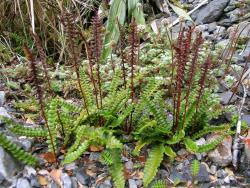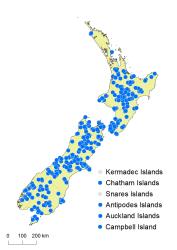- = Polypodium penna-marina Poir., Encycl. 5, 520 (1804)
- ≡ Lomaria penna-marina (Poir.) Trevis., Atti Reale Ist. Veneto Sci. Lett. Arti III, 14: 570 (1869)
- ≡ Spicanta penna-marina (Poir.) Kuntze, Revis. Gen. Pl. 2, 821 (1891)
- ≡ Struthiopteris penna-marina (Poir.) Maxon & C.V.Morton, Bull. Torrey Bot. Club 66: 44 (1939)
- ≡ Austroblechnum penna-marina (Poir.) Gasper & V.A.O.Dittrich in Gasper et al., Phytotaxa 275: 203 (2016)
Rhizomes short- to long-creeping, up to 250 mm long (in herbarium material), bearing scales. Rhizome scales ovate or triangular, 1.3–3 mm long, 0.6–1.8 mm wide, pale brown, concolorous. Fronds strongly dimorphic; sterile fronds 15–400 mm long, prostrate or semi-erect; fertile fronds on same plant longer, 35–430 mm long, up to twice the length of the sterile, held erect. Sterile fronds. Stipes 5–190 mm long, red-brown, bearing scales that become more scattered distally. Rachises yellow-brown, grooved adaxially, glabrous or with a few scattered scales. Laminae 10–235 mm long, 3–25 mm wide, pinnatisect, linear to narrowly elliptic, tapering to a pinnatifid apex, similar colour on both surfaces, coriaceous, glabrous or with a few scattered scales. Pinnae in 12–44 pairs, closely spaced, triangular or oblong, straight, gradually reducing to the lamina base; the longest pinnae at or about the middle, 2–13 mm long, 1–6 mm wide, apices acute to obtuse, margins entire or shallowly dentate, bases adnate; the basal pinnae ± opposite. Veins free. Fertile fronds. Stipes 15–280 mm long. Laminae 15–240 mm long, 4–18 mm wide. Pinnae in 10–36 pairs, linear to narrowly oblong, falcate or straight, the longest 2–9 mm long, 1–3 mm wide, replaced by tiny sterile flanges at the lamina base. Sori and indusia in one row either side of costa, continuous along the length of the pinna.
Blechnum penna-marina is widely distributed in the southern hemisphere, occurring in Chile, Bolivia, Brazil, Argentina, the Falkland Islands, Tristan da Cunha, Gough Island, Marion Island, Kerguelen Island, Amsterdam Island, and Crozet Islands, as well as Australia, New Zealand and Macquarie Island (Chambers & Farrant 1996). Four subspecies were recognised by Chambers & Farrant (1996), but only subsp. alpina occurs in the Australasian region. The other three are confined to South America and islands in the South Atlantic and southern Indian Oceans. Subsp. microphyllum has fronds no more than 280 mm tall, with the sterile pinnae constricted close to the rachis, and often distinctly crenate; it is known only from a small area in Chile. Subsp. boliviana is a much more robust plant with fronds up to 730 mm long and 30 mm wide, occurring in mountainous areas of Bolivia and southern Brazil. Subsp. penna-marina is more similar to subsp. alpina but is distinguished by its purplish-black stipe and larger and more imbricate pinnae; it is distributed through Brazil, Chile, the Falkland Islands and other islands of the Southern Ocean. However, these subspecies are not universally accepted; for example, some authorities treat subsp. microphyllum at species level (e.g. Zuloaga et al. 2008).
Blechnum penna-marina is characterised by its dimorphic fronds, free veins, pinnatisect sterile laminae, and continuous sori. It has a creeping rhizome, and sterile laminae that are linear to narrowly elliptic, bearing oblong or triangular pinnae with entire or shallowly dentate margins. The basal pinnae are usually opposite. The fertile fronds are up to twice as long as the sterile. The general shape and dimensions of the laminae in B. penna-marina are similar to those of B. banksii and B. membranaceum, but B. penna-marina is distinguished by its creeping rhizome and much longer fertile fronds.
North Island: Northland, Auckland, Volcanic Plateau, Gisborne, Taranaki, Southern North Island.
South Island: Western Nelson, Sounds-Nelson, Marlborough, Westland, Canterbury, Otago, Southland, Fiordland.
Chatham Islands, Stewart Island, Auckland Islands, Campbell Island, Antipodes Islands.
Altitudinal range: 0–1900 m.
In the North Island Blechnum penna-marina is common in lowland to alpine areas from Hamilton and East Cape south to Wellington, with outlying populations near Warkworth, and at Ahipara. It ranges from near sea level, up to 1375 m on Mt Taranaki and in the Ruahine Ranges. It is common in lowland to alpine areas throughout the South Island and Stewart Island. It grows from near sea level, up to 1900 m in the Spenser Mountains, Nelson. It also extends to the Chatham Islands and most of the subantarctic islands.
Also Australia (New South Wales, Victoria, Tasmania), MacQuarie Island, Chile, Argentina, Falkland Islands (Chambers & Farrant 1996).
Blechnum penna-marina is a terrestrial fern found in podocarp, broadleaved and beech forest, under mānuka and Salix species, in pine forest, in Sphagnum bog and wet pasture, and in subalpine scrub, tussock grassland and rocky herbfield. It grows on creek banks and in creek beds, on river terraces, at forest margins, along tracksides and roadsides, on clay banks, among rocks and scree, in dune hollows and coastal turf, in swamps and on peaty soils, and in subalpine habitats.
| Category | Number |
|---|---|
| Indigenous (Non-endemic) | 1 |
| Total | 1 |
Chambers & Farrant (1996) cited Commerson’s specimen (P 00307041) as the holotype. However, this may not have been the only element examined by Poiret (1804). The protologue says that the specimen consulted was “v.s. in herb. Desfont.”, and the specimen at FI is clearly marked as “ex Hb Desfontaines”. Hence more than one specimen has a claim to be original material, and the designation by Chambers & Farrant (1996) should be changed from holotype to lectotype (Art. 9.10).





